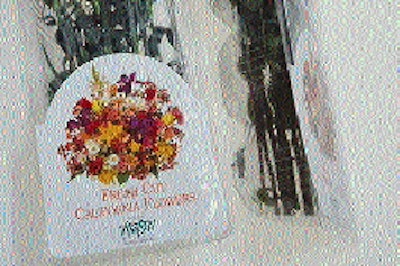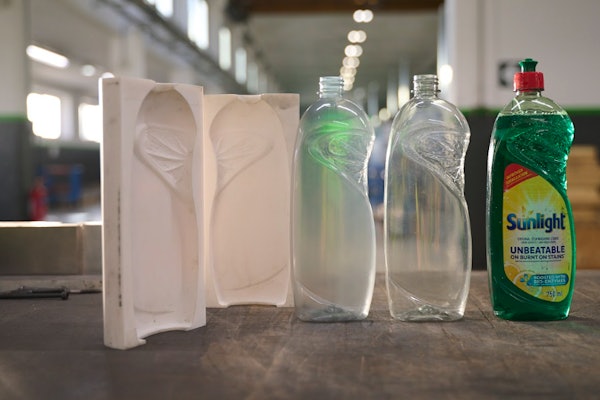
Foodservice institutions around the country rely on a steady stream of fresh produce from the bountiful growing area around California's Salinas Valley. But the foodservice distribution system that delivers fruits and veggies to the other 49 states has rarely been able to include fresh flowers grown in California. The reason is simple enough: Flowers are traditionally distributed either in tubs of water or in corrugated boxes with ice packs. The former method is too heavy and messy for foodservice distributors to deal with, and the latter offers inadequate shelf life.
Now that's begun to change, thanks to the pioneering efforts of Salinas-based Matsui Wholesale Florist. "Pioneering" may not be the most accurate word to describe Matsui's year-old program; the modified-atmosphere packaging technology used by Matsui has been used for produce for some time now. But Matsui is the first to try it with flowers, and the firm now gets a three-week refrigerated shelf life on light-weight, dry-packed flowers in clear, protective packages.
"In our business, there never has been a good way to get flowers from growers to foodservice distribution centers and then to individual restaurants, hotels or other institutions," says Matsui general manager John Costello. "The extended shelf life and handling ease of this package let us do just that. The flowers the customer receives are as fresh as the day they were picked."
Freshness is only one part of the picture. More important to foodservice distributors is that the flowers are dry-packed. Handling buckets of water is out of the picture. The 21-day shelf life of the new package also triples that of ice-packed flowers in boxes.
Three-component package
The extended shelf life is a function of three packaging components that work together as a system. First is the thermoformed polyvinyl chloride tray in two different sizes: 27" long x 3 1/2" deep x 6" wide or 15" long x 3 1/2" deep x 8 1/4" wide. Supplied by VGS (Salinas, CA), it's lidded with a 1.5-mil Mylar® polyester film from DuPont (Wilmington, DE).
The rigid tray provides protection and clarity. So does the lidding material, whose heat-seal coating produces seals that won't burst when the pressure changes during air shipment. (A portion of Matsui's shipments go by air.) The lidding also displays gloss and anti-fog properties that let the flowers' natural beauty show through.
The third component in the package is a polypropylene-based FreshHold® spot label, applied to the lidding like any p-s label. It covers a small hole that is punched into the lidding material. The label permeability allows gases to pass in and out of the package at a predetermined rate, depending on the FreshHold label formulation. The permeability of tray and lid are also taken into account. The package's total permeability results in an internal atmosphere high in carbon dioxide, which is given off by the flowers, but low in oxygen. This lets the flowers respire, thus allowing them to stay fresh. The technology, introduced about four years ago and now quite popular among produce marketers, is available through FWM/Fisher Holdings (Salinas, CA), which holds several patents on it.
Package fits right in
"The beauty of the package as we use it is that we don't change the existing produce distribution system at all," says Costello.
Sysco Foodservice, for example, receives Matsui's flowers in its central warehouses across the country on the same refrigerated trucks that carry edible produce from the Salinas region. In turn, when those warehouses load up their trucks for delivery to restaurants and other institutions, the flowers are handled no differently than the rest of the items.
"Our product rides in the same trucks that take fresh produce to foodservice institutions," says Costello. This ability to mix produce and flowers is significant, because some produce gives off ethylene gas as it respires, and ethylene gas causes flowers to wilt and die. "It can kill carnations overnight," says Costello.
In Matsui's case, the flowers are protected from ethylene gas because the package increases levels of CO2 and depletes O2. By the time the packaged flowers enter a delivery truck and are exposed to ethylene given off by the produce, the concentration of CO2 inside each package negates the ethylene's ability to attack the flowers' cells.
Production in Salinas facility
To produce its FreshHold packages, Matsui installed three heat sealers made by RMC Corp. (Salinas, CA). All three are operated by hand. In each case, a preformed tray is placed in the machine and is loaded with anywhere from 12 to 20 stems. The operator then pulls roll-fed lidding material over the tray and activates a sealing platen that comes down to seal the lidding to the tray.
The platen also incorporates a hole punch to make the hole in the film over which the FreshHold label is applied. A pressure-sensitive label is pulled from its release liner and applied by hand. Also applied is a second p-s label that carries graphics, product description and information about Matsui. Supplied by Hurst Labeling Systems (Burbank, CA), it's printed flexographically in six colors.
The finished trays are then multi-packed in corrugated shippers with vent holes in them that allow for rapid cool-down.
The ultimate beneficiary of the FreshHold package, of course, is the hospital foodservice director who decorates patients' food trays with a carnation, or the manager of an upscale restaurant who puts a bouquet on each table. Unless they order flowers through their foodservice distributor, they have to buy from a local source. When the flowers arrive, they must be used almost immediately.
With the FreshHold package, trays of flowers can be stored conveniently in the walk-in cooler for a week or more. The date stamped on the corrugated shipper tells the foodservice manager how much time he has before the flowers are unusable. Plus the manager deals with one less vendor at his delivery dock. When broccoli and cauliflower show up, flowers are on the same foodservice distributor's truck.
And what does the foodservice manager pay for all this convenience? If flowers are purchased from a retail florist, the foodservice manager could save money with the FreshHold package because it comes through a wholesaler, not a retailer. But if flowers are purchased wholesale, the FreshHold package is likely to cost "a little more," says Costello, since the packaging components are not inexpensive. Costello adds that the exact numbers are elusive since costs in the foodservice supply chain vary from distributor to distributor and customer to customer.
Whatever the cost, foodservice operators can choose from 20 flower varieties in the new package. "It's gotten us into a market we couldn't reach before," says Costello.























